MICROSCOPE
MAKER:Charles Baker Company
MODEL:'Nelson-Curties No 1a' or 'Nelson-Curties No 1A'
c.1900
SIGNED: 'BAKER 244 HIGH HOLBORN LONDON '
SIGNED ON THE SIDE OF THE TOP OF THE UPPER DRAW TUBE:'AGENTS, SHARLAND & CO, AUCKLAND
SERIAL(?) NUMBER: 322
The condensers include:
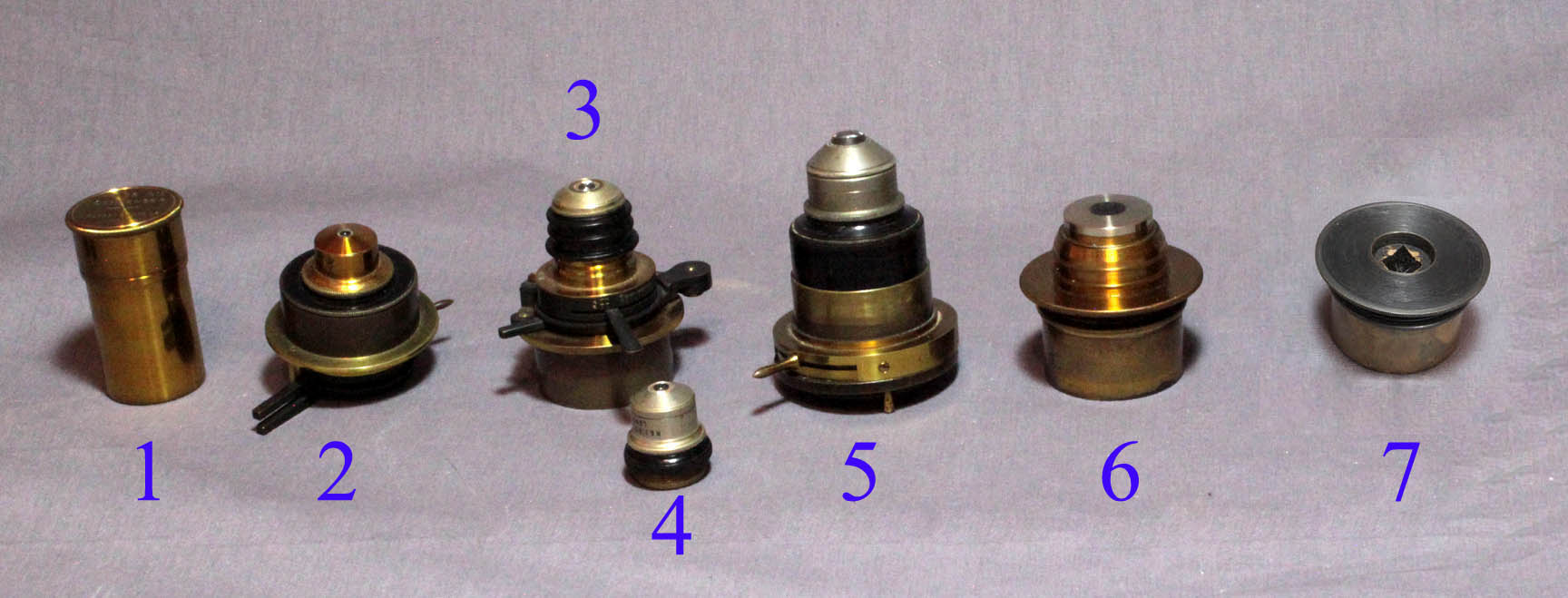
The condensers and accompanying accessories for the Nelson No 1a Microscope include(from left to right):
1. Can to hold the optical elements of the Watson holos high power oil immersion condenser
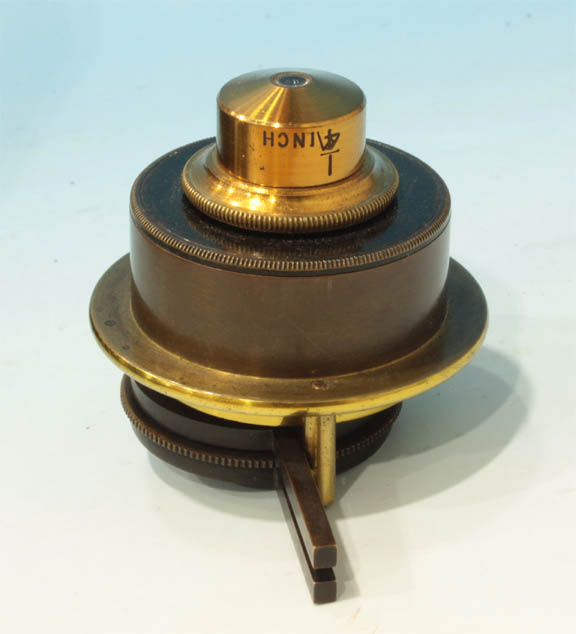 2. An unsigned condenser housing with two turn-out filter or insert holders, the top one for holding the monochromatic glass filter(see below) and the bottom one with a knurled ring providing rotation, and accepting any of the included (22 mm) dark ground stops or oblique lighting inserts. It also has a working iris diaphragm which makes a total of three areas under the optics to modify the illumination. It has an RMS thread and so accepts two optical parts that fit this including one signed '1/4 inch' in lacquered brass and another in nickel finish by R. & J Beck Ltd , London, labeled 7mm and N.A. 1.0.
2. An unsigned condenser housing with two turn-out filter or insert holders, the top one for holding the monochromatic glass filter(see below) and the bottom one with a knurled ring providing rotation, and accepting any of the included (22 mm) dark ground stops or oblique lighting inserts. It also has a working iris diaphragm which makes a total of three areas under the optics to modify the illumination. It has an RMS thread and so accepts two optical parts that fit this including one signed '1/4 inch' in lacquered brass and another in nickel finish by R. & J Beck Ltd , London, labeled 7mm and N.A. 1.0.
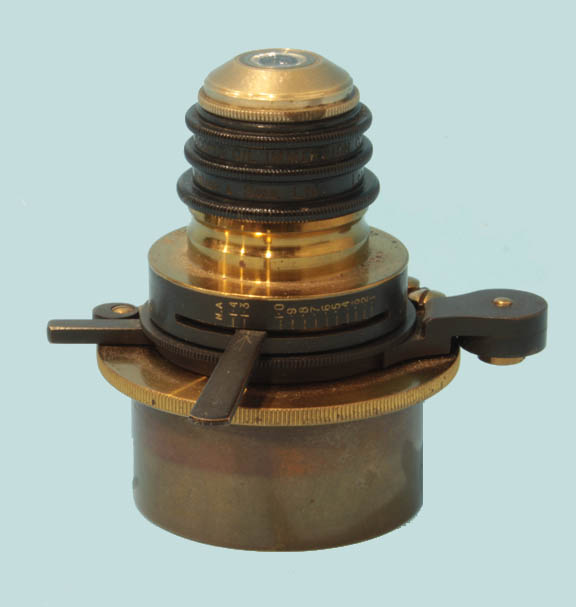 3. Watson condenser housing into which a Watson Holos oil immersion condenser (NA 1.30) with removable immersion front is shown installed. This condenser housing has a single small swing-out insert/filter holder with a knurled ring to rotate the inserts. It will also accept the other two RMS fitting condensers noted in 2. above. High quality features include the facility to adjust the centration of the filter holder and calibration of the iris diaphragm adjustment for numerical aperture with an arrow on the lever to point to the engraved n.a. on the condenser housing.
3. Watson condenser housing into which a Watson Holos oil immersion condenser (NA 1.30) with removable immersion front is shown installed. This condenser housing has a single small swing-out insert/filter holder with a knurled ring to rotate the inserts. It will also accept the other two RMS fitting condensers noted in 2. above. High quality features include the facility to adjust the centration of the filter holder and calibration of the iris diaphragm adjustment for numerical aperture with an arrow on the lever to point to the engraved n.a. on the condenser housing.
4. is the 7 mm condenser, RMS threaded, that can fit the same housing as the Holos Oil Condenser or the other housing (2.) above.
5. 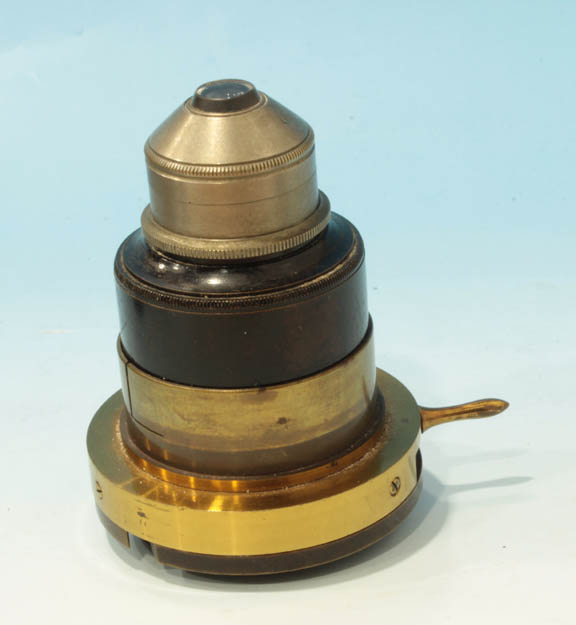 Large Abbe-type condenser with large swing-out holder for the included 35 mm dark ground stops and oblique lighting inserts. The insert/filter holder incorporates a knurled ring to rotate the inserts while in place. The top element (press fit) is removable for low power work.
Large Abbe-type condenser with large swing-out holder for the included 35 mm dark ground stops and oblique lighting inserts. The insert/filter holder incorporates a knurled ring to rotate the inserts while in place. The top element (press fit) is removable for low power work.
6. 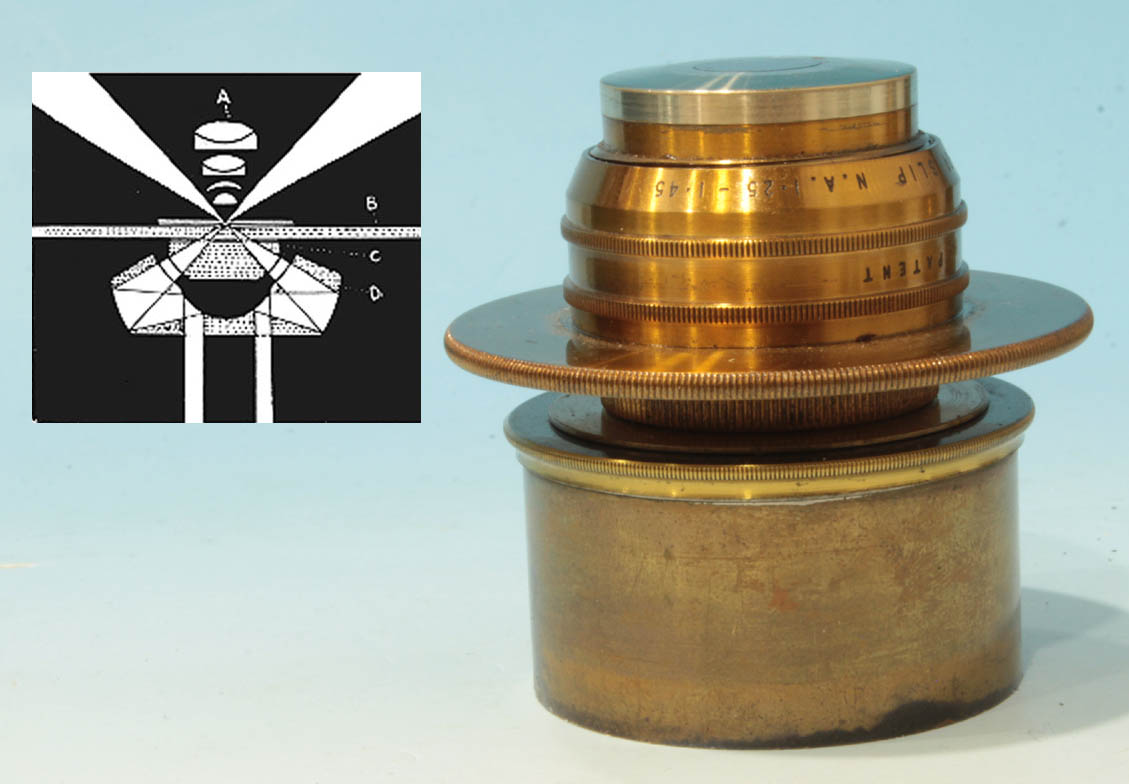 The Beck
The Beck Patent Focussing Dark Ground Immersion Illuminator
n.a. 1.25 – 1.45 rated for slides of 0.04 inch(1 mm) thickness. It is signed R & J. BECK. LTD, .02 SLIP N.A. 1.33-1.45
. The focussing feature allowed for variation in slide thickness. According to the Beck Catalog, although rated for a 1 mm slide thickness, the focusing adjustment allows it to be used with slides 1/2 mm to 1.5 mm thick. It is stated in a 1930s Beck catalog that when the top element is removed this condenser is a good dry darkfield condenser for low power objectives provided the N.A. does not exceed 0.7, but this example does not have a removeable top element. The basic form of this device was described in Conrad Beck's 1921 The Microscope, a Simple Handbook. It was also described in Gage's THE MICROSCOPE, AN INTRODUCTION TO MICROSCOPIC METHODS AND HISTOLOGY, DARK-FIELD EDTIION. (14TH REVISED) of 1925, p436-. The focusing mechanism was originally controlled by a lever; this later version has the focusing controlled by the large knurled disk. It is designed on the cardioid principal, which is still used for dark ground illumination today.
7. 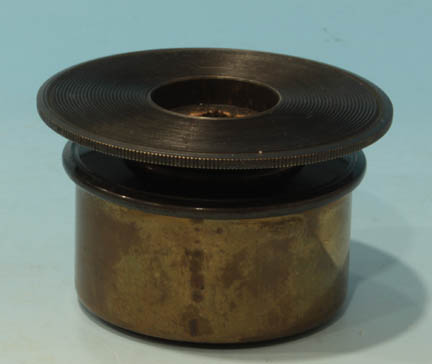
A large Nicol-prism polarizer (period addition)
Shown below are two sets of stops and oblique illumination inserts to fit the two different size holders in the condensers. Each set is in a small matching brass can. Those on the left have a diameter of 22 mm while those on the right are 35 mm in diameter. The smaller ones fit the unsigned achromatic condenser housing (number 2 above) as well as the Watson condenser housing (number 3 above). The unsigned smaller condenser (number 2 above), has two swing out filter holders, so that the blue filter can be used above one of the other inserts if desired. The larger diameter inserts fit only the large unsigned Abbe-type condenser (number 5).
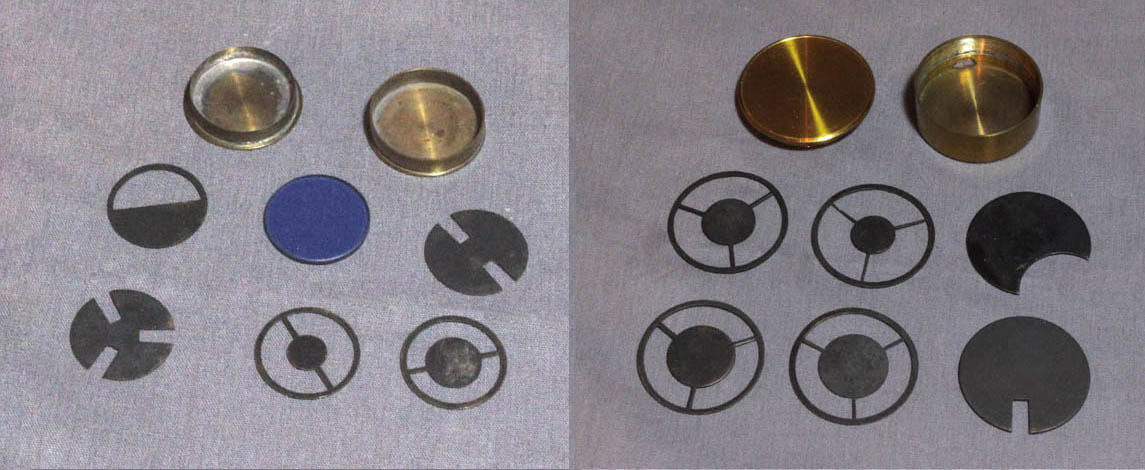
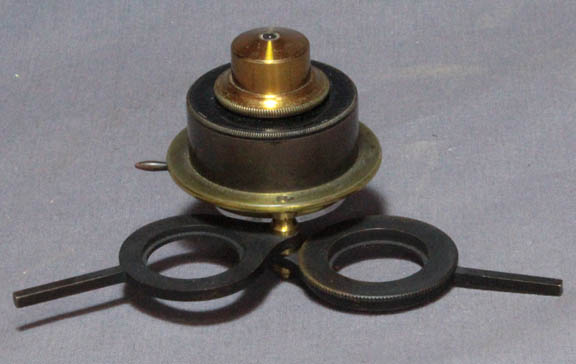
The unsigned condenser is shown to the right, with its two insert holders exposed. The lower of the two, on the right side of the image, has a knurled ring to allow it to be rotated changing the direction of illumination of an asymmetrical opening of an insert.

 2. An unsigned condenser housing with two turn-out filter or insert holders, the top one for holding the monochromatic glass filter(see below) and the bottom one with a knurled ring providing rotation, and accepting any of the included (22 mm) dark ground stops or oblique lighting inserts. It also has a working iris diaphragm which makes a total of three areas under the optics to modify the illumination. It has an RMS thread and so accepts two optical parts that fit this including one signed '1/4 inch' in lacquered brass and another in nickel finish by R. & J Beck Ltd , London, labeled 7mm and N.A. 1.0.
2. An unsigned condenser housing with two turn-out filter or insert holders, the top one for holding the monochromatic glass filter(see below) and the bottom one with a knurled ring providing rotation, and accepting any of the included (22 mm) dark ground stops or oblique lighting inserts. It also has a working iris diaphragm which makes a total of three areas under the optics to modify the illumination. It has an RMS thread and so accepts two optical parts that fit this including one signed '1/4 inch' in lacquered brass and another in nickel finish by R. & J Beck Ltd , London, labeled 7mm and N.A. 1.0.  3. Watson condenser housing into which a Watson Holos oil immersion condenser (NA 1.30) with removable immersion front is shown installed. This condenser housing has a single small swing-out insert/filter holder with a knurled ring to rotate the inserts. It will also accept the other two RMS fitting condensers noted in 2. above. High quality features include the facility to adjust the centration of the filter holder and calibration of the iris diaphragm adjustment for numerical aperture with an arrow on the lever to point to the engraved n.a. on the condenser housing.
3. Watson condenser housing into which a Watson Holos oil immersion condenser (NA 1.30) with removable immersion front is shown installed. This condenser housing has a single small swing-out insert/filter holder with a knurled ring to rotate the inserts. It will also accept the other two RMS fitting condensers noted in 2. above. High quality features include the facility to adjust the centration of the filter holder and calibration of the iris diaphragm adjustment for numerical aperture with an arrow on the lever to point to the engraved n.a. on the condenser housing. Large Abbe-type condenser with large swing-out holder for the included 35 mm dark ground stops and oblique lighting inserts. The insert/filter holder incorporates a knurled ring to rotate the inserts while in place. The top element (press fit) is removable for low power work.
Large Abbe-type condenser with large swing-out holder for the included 35 mm dark ground stops and oblique lighting inserts. The insert/filter holder incorporates a knurled ring to rotate the inserts while in place. The top element (press fit) is removable for low power work.  The Beck
The Beck 

